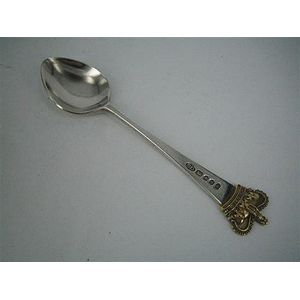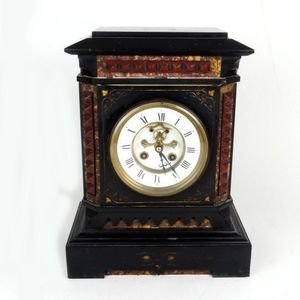Black Slate Mantel Clock with Brocot Escapement
A black slate and porphyry cased mantel clock, white annular enamel dial with Roman numerals, Brocot escapement, height 33 cm
You must be a subscriber, and be logged in to view price and dealer details.
Subscribe Now to view actual auction price for this item
When you subscribe, you have the option of setting the currency in which to display prices to $Au, $US, $NZ or Stg.
This item has been sold, and the description, image and price are for reference purposes only.
- Brocot Escapement - The Brocot escapement was invented by the French clockmaker Achille Brocot in 1828. It is a type of escapement, which is a mechanism in a timepiece that controls the movement of the gears and regulates the timekeeping accuracy.
The Brocot escapement is a variation of the detent escapement and it is used in pendulum and spring-driven clocks. It uses a pair of pallets that engage and lock the escape wheel, allowing the clock's power to be transferred to the balance wheel. The escapement also allows the clock's gears to advance in small, precise increments, which helps to improve the clock's timekeeping accuracy. The Brocot escapement was widely used in 19th century for both domestic and public clocks, also it was widely used in marine chronometers.
The Brocot escapement is known for its high accuracy and stability - Porphyry - In geology, porphyry is a type of igneous rock with a distinctive texture. It has large, visible crystals (called phenocrysts) embedded in a fine-grained groundmass. In the ancient world, porphyry was a highly prized material used for sculptures, sarcophagi, and other decorative objects. Porphyry wasn't widely used in furniture throughout the 19th century, but was used as a luxury and prestigious material.
Due to its high cost and difficulty in working with, porphyry was primarily used for smaller accent pieces or decorative elements on furniture. This could include tabletops, inlays, veneers, or ornamental details on legs or columns. It was also used for furniture pieces commissioned for royalty, wealthy patrons, or important public buildings. For example, some European palaces feature furniture with porphyry elements.
This item has been included into following indexes:
-
clocks, material or decoration
- marble or slate, black 342
- slate 344
Visually similar items

A Silver Jubilee commemorative spoon, Stuart Devlin, London 1977
Sold by
in
for
You can display prices in $Au, $US, $NZ or Stg.

A Lalique 'Champs Elysee' bowl, crystal, signed to base. Length 45 cm
Sold by
in
for
You can display prices in $Au, $US, $NZ or Stg.

Rare Georgian Scottish provincial sterling silver toddy ladle, fiddle pattern, marks, Anchor & Rope, G, Stag, DG approx 15 cm long, 30g
Sold by
in
for
You can display prices in $Au, $US, $NZ or Stg.

Rare Charles Schneider orange and green art glass vase, 28.5 cm high
Sold by
in
for
You can display prices in $Au, $US, $NZ or Stg.
